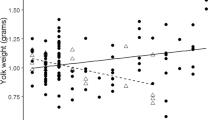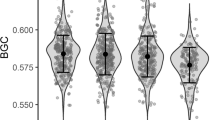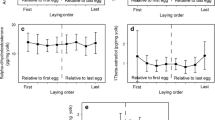Abstract
Maternal hormones can have substantial phenotypic effects in the progeny of many vertebrates. It has been proposed that mothers adaptively adjust hormone levels experienced by particular young to optimize their reproductive output. In birds, systematic variation in egg hormone levels has been related to different female reproductive strategies. Because in many bird species prospects of the offspring change seasonally and with brood number, strategic adjustment of yolk androgen levels would be expected. To test this idea, we induced pied flycatcher (Ficedula hypoleuca) females to nest twice during the same season by removing their first clutches shortly after clutch completion. We collected eggs of first and replacement clutches to measure yolk concentrations of androstenedione (A4) and testosterone (T) and captured the females that laid these clutches for phenotypic measurements. Although average egg androgen levels were remarkably consistent within females, hormone patterns differed considerably between first and replacement clutches. Eggs of replacement clutches were heavier with larger yolks compared to first clutches, but they contained on average lower levels of androgens. Within clutches, androgen concentration increased over the laying sequence in the first clutch, but decreased or remained more constant over the laying sequence in the replacement clutch. Mean yolk T, but not A4 levels, were negatively associated with laying date for both breeding attempts. Moreover, females in good body condition produced eggs containing lower levels of androgens than females in poor condition. Our results are consistent with the idea that differences in yolk androgen levels may be one mechanism underlying seasonal variation in reproductive success and it is possible that changes in egg androgen patterns may reflect a change in female reproductive strategy. High within-female consistency also highlights the possibility that there may be some underlying genetic variation in yolk androgen levels.




Similar content being viewed by others
References
Amundsen T, Slagsvold T (1991) Asynchronous hatching in the pied flycatcher: an experiment. Ecology 72:797–804
Christians JK (2002) Avian egg size: variation within species and inflexibility within individuals. Biol Rev 77:1–27
Clark MM, Galef J (1995) Prenatal influences on reproductive life history strategies. Trends Ecol Evol 10:151–153
Clark AB, Wilson DS (1981) Avian breeding adaptations, hatching asynchrony, brood reduction and nest failure. Q Rev Biol 56:253–277
Daan S, Dijkstra C, Tinbergen JM (1990) Family planning in the kestrel (Falco tinnunculus): the ultimate control of covariation of laying date and clutch size. Behaviour 114:83–116
Daan S, Dijkstra C, Weissing F (1996) An evolutionary explanation for seasonal trends in avian sex ratios. Behav Ecol 7:426–430
Drent RH, Daan S (1980) The prudent parent: energetic adjustment in avian breeding. Ardea 68:225–252
Eising CM, Eikenaar C, Schwabl H, Groothuis TG (2001) Maternal androgens in black-headed gull (Larus ridibundus) eggs: consequences for chick development. Proc R Soc Lond Ser B 268:839–846
Eising CM, Groothuis TGG (2003) Yolk androgens and begging behaviour in black-headed gull chicks: an experimental field study. Anim Behav 66:1027–1034
Gil D, Graves J, Hazon N, Wells A (1999) Male attractiveness and differential testosterone investment in zebra finch eggs. Science 286:126–128
Gil D, Leboucher G, Lacroix A, Cue R, Kreutzer M (2004) Female canaries produce eggs with greater amounts of testosterone when exposed to preferred male song. Horm Behav 45:64–70
Gil D, Ninni P, Lacroix A, De Lope F, Tirard C, Marzal A, Moller AP (2005) Yolk androgens in the barn swallow (Hirundo rustica): a test of some adaptive hypotheses. J Evol Biol 19:123–131
Groothuis TGG, Eising C, Dijkstra C, Müller W (2005a) Balancing between costs and benefits of maternal hormone deposition in avian eggs. Biol Lett 1:78–81
Groothuis TGG, Müller W, von Engelhardt N, Carere C, Eising C (2005b) Maternal hormones as a tool to adjust offspring phenotype in avian species. Neurosci Biobehav Rev 29:329–352
Hemborg C (1999) Sexual differences in moult-breeding overlap and female reproductive costs in pied flycatchers, Ficedula hypoleuca. J Anim Ecol 68:429–436
Hemborg C, Lundberg A (1998) Costs of overlapping reproduction and moult in passerine birds: an experiment with the pied flycatcher. Behav Ecol Sociobiol 43:19–23
Ketterson ED, Nolan V Jr, Sandell MI (2005) Testosterone in females: mediator of adaptive traits, constraint on sexual dimorphism, or both? Am Nat 166:S85–S98
Krist M, Remes V, Uvirova L, Nadvornik P, Bures S (2004) Egg size and offspring performance in the collared flycatcher (Ficedula albicollis): a within-clutch approach. Oecologia 140:52–60
Lack D (1966) Population studies of birds. Clarendon Press, Oxford
Lessells CM, Boag PT (1987) Unreapetable repeatabilities: a common mistake. Auk 104:116–121
Lessells CM, Mateman AC, Visser J (1996) Great tit hatchling sex ratios. J Avian Biol 27:135–142
Lifjeld JT, Johnsen A, Petitguyot T (2005) Egg-size variation in the bluethroat (Luscinia s. svecica): constraints and adaptation. J Ornithol 146:249–256
Littell RC, Milliken GA, Stroup WW, Wolfinger RD (2004) SAS system for mixed models. SAS Institute, Cary, N.C.
Lundberg A, Alatalo RV (1992) The pied flycatcher. Poyser, London
Magrath RD (1989) Hatching asynchrony and reproductive success in the blackbird. Nature 339:536–538
Mazuc J, Chastel O, Sorci G (2003) No evidence for differential maternal allocation to offspring in the house sparrow (Passer domesticus). Behav Ecol 14:340–346
McCormick MI (1999) Experimental test of the effect of maternal hormones on larval quality of a coral reef fish. Oecologia 118:412–422
Mousseau TA, Fox CW (1998) Maternal effects as adaptations. Oxford University Press, New York
Müller W, Eising CM, Dijkstra C, Groothuis TGG (2002) Sex differences in yolk hormones depend on maternal social status in Leghorn chickens (Gallus gallus domesticus). Proc R Soc Lond Ser B 269:2249–2255
Müller W, Eising CM, Dijkstra C, Groothuis TGG (2004) Within-clutch patterns of yolk testosterone vary with the onset of incubation in black-headed gulls. Behav Ecol 15:893–897
Müller W, Groothuis TGG, Kasprzik A, Dijkstra C, Alatalo RV, Siitari H (2005) Prenatal androgen exposure modulates cellular and humoral immune function of black-headed gull chicks. Proc R Soc Lond Ser B 272:1971–1977
Nilsson SG (1984) The evolution of nest-site selection among hole-nesting birds: the importance of nest predation and competition. Ornis Scand 15:167–175
Nilsson J-Å (2000) Time-dependent reproductive decisions in the blue tit. Oikos 88:351–361
Perrins CM (1970) The timing of birds’ breeding seasons. Ibis 112:242–255
Pilz KM, Smith HG, Sandell MI, Schwabl H (2003) Interfemale variation in egg yolk androgen allocation in the European starling: do high-quality females invest more? Anim Behav 65:841–850
Pilz KM, Quiroga M, Schwabl H, Adkins-Regan E (2004) European starling chicks benefit from high yolk testosterone levels during a drought year. Horm Behav 46:179–192
Pilz KM, Adkins-Regan E, Schwabl H (2005) No sex differences in yolk steroid concentrations of avian eggs at laying. Biol Lett 1:318–321
Price T (1998) Maternal and paternal effects in birds: effects on offspring fitness. In: Mousseau TA, Fox CW (eds) Maternal effects as adaptations. Oxford University Press, Oxford, pp 202–226
Qvarnström A, Pärt T, Sheldon BC (2000) Adaptive plasticity in mate preference linked to differences in reproductive effort. Nature 405:344–347
Reed WL, Vleck CM (2001) Functional significance of variation in egg-yolk androgens in the American coot. Oecologia 128:164–171
Rosivall B, Török J, Hasselquist D, Bensch S (2004) Brood sex ratio adjustment in collared flycatchers (Ficedula albicollis): results differ between populations. Behav Ecol Sociobiol 56:346–351
Rowe L, Ludwig D, Schluter D (1994) Time, condition and the seasonal decline of avian clutch size. Am Nat 143:698–722
Schwabl H (1993) Yolk is a source of maternal testosterone for developing birds. Proc Natl Acad Sci USA 90:11446–11450
Schwabl H (1996) Maternal testosterone in the avian egg enhances postnatal growth. Comp Biochem Physiol 114:271–276
Schwabl H, Mock DW, Gieg JA (1997) A hormonal mechanism for parental favouritism. Nature 386:231
Sheldon BC, Merilä J, Lindgren G, Ellegren H (1998) Gender and environmental sensitivity in nestling collared flycatchers. Ecology 79:1939–1948
Siikamaki P (1998) Limitation of reproductive success by food availability and breeding time in pied flycatchers. Ecology 79:1789–1796
Slagsvold T (1986) Asynchronous versus synchronous hatching in birds: experiments with the pied flycatcher. J Anim Ecol 55:1115–1134
Slagsvold T, Lifjeld JT (1988) Ultimate adjustment of clutch size to parental feeding capacity. Ecology 69:1918–1922
Slagsvold T, Lifjeld J (1989) Constraints on hatching asynchrony and egg size in pied flycatchers. J Anim Ecol 58:837–849
Sockman KW, Schwabl H (2000) Yolk androgens reduce offspring survival. Proc R Soc Lond Ser B 267:1451–1456
Stearns SC (2003) The evolution of life histories. Oxford University Press, New York
Tanvez A, Beguin N, Chastel O, Lacroix A, Leboucher G (2004) Sexually attractive phrases increase yolk androgens deposition in Canaries (Serinus canaria). Gen Comp Endocrinol 138:113–120
Tschirren B, Richner H, Schwabl H (2004) Ectoparasite-modulated deposition of maternal androgens in great tit eggs. Proc R Soc Biol Sci Ser B 271:1371–1375
Tschirren B, Saladin V, Fitze PS, Schwabl H, Richner H (2005) Maternal yolk testosterone does not modulate parasite susceptibility or immune function in great tit nestlings. J Anim Ecol 74:675–682
Uller T, Olsson M (2003) Prenatal exposure to testosterone increases ectoparasite susceptibility in the common lizard (Lacerta vivipara). Proc R Soc Lond Ser B 270:1867–1870
Veiga JP (1992) Hatching asynchrony in the house sparrow: a test of the egg-viability hypothesis. Am Nat 139:669–675
Wingfield JC, Farner DS (1979) Some endocrine correlates of renesting after loss of clutch or brood in the white-crowned sparrow, Zonotrichia leucophrys gambelii. Gen Comp Endocrinol 38:322–331
Winkler DW, Allen PE (1996) The seasonal decline in Tree Swallow clutch size: physiological constraint or strategic adjustment? Ecology 77:922–932
Acknowledgements
We thank Henrik Smith for statistical advice and comments on an earlier draft. Four anonymous reviewers provided helpful comments that improved the quality of the manuscript. The study was approved by the ethical committee for animal research, Malmö/Lund, Sweden. Financial support was provided by the Swedish Research Council (to M. Sandell).
Author information
Authors and Affiliations
Corresponding author
Additional information
Communicated by Markku Orell.
Rights and permissions
About this article
Cite this article
Tobler, M., Granbom, M. & Sandell, M.I. Maternal androgens in the pied flycatcher: timing of breeding and within-female consistency. Oecologia 151, 731–740 (2007). https://doi.org/10.1007/s00442-006-0610-1
Received:
Accepted:
Published:
Issue Date:
DOI: https://doi.org/10.1007/s00442-006-0610-1




